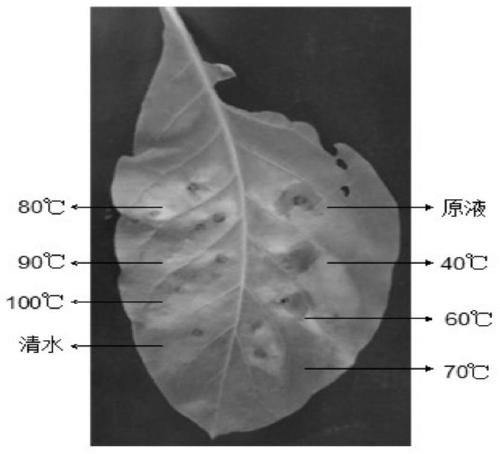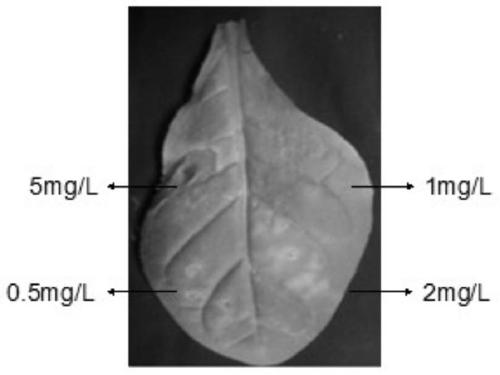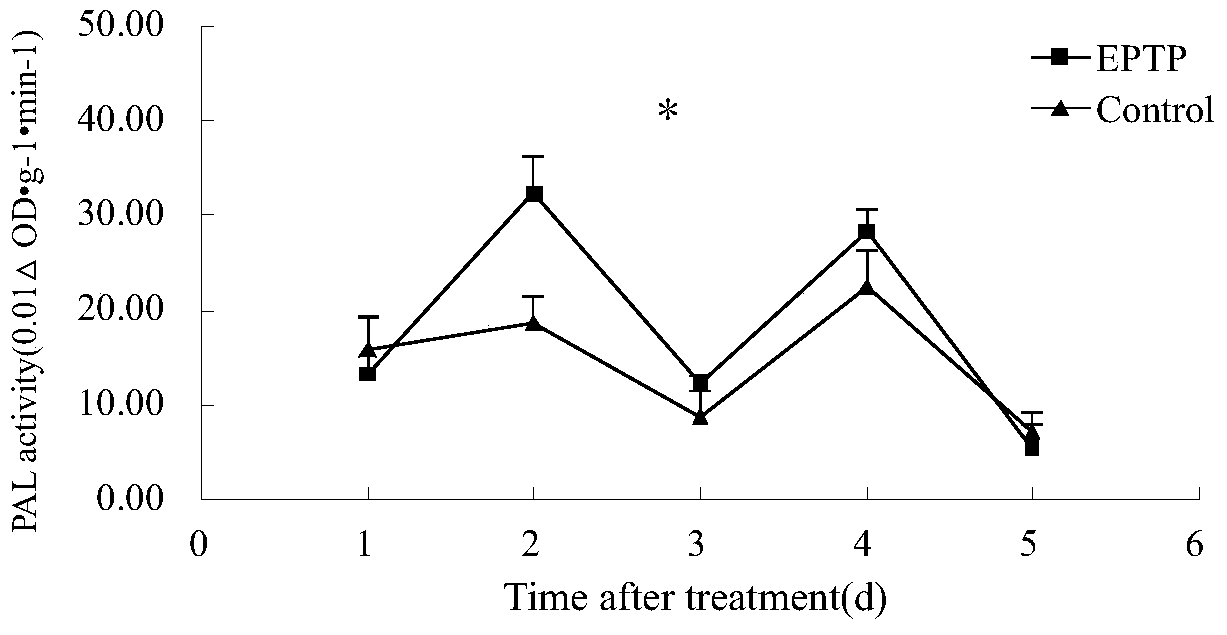A penicillium protein elicitor eptp and its application in improving plant disease resistance
A technology of disease resistance and protein, which is applied in the improvement of plant disease resistance. In the field of penicillin protein elicitor EPTP, it can solve the problem of less protein elicitor discovery, achieve the effects of inhibiting proliferation, low production cost, and good control effect Effect
- Summary
- Abstract
- Description
- Claims
- Application Information
AI Technical Summary
Problems solved by technology
Method used
Image
Examples
Embodiment 1
[0045] Detect the physicochemical properties of the protein elicitor EPTP:
[0046] (1) thermal stability identification
[0047] Take EPTP (artificially synthesized according to the sequence shown in SEQ ID NO.2, 10 μg / ml) and incubate at 40°C, 60°C, 70°C, 80°C, 90°C, and 100°C for 5 min, put them on ice quickly, and wait until the solution After cooling down to room temperature, the allergic reaction test was carried out. The thermal stability of EPTP was examined.
[0048] The subject of the experiment is Yunyan 87, which grows healthily. The healthy and complete leaves are taken, and the half-leaf injection method is used. The left side of the leaves is the water control, and the right side is EPTP. Inject 20 μL of EPTP or water at each point using a microsyringe without a needle. After 6 days, the leaves were cut and photographed to observe whether allergic spots appeared on the leaves and the shape of allergic spots. The presence of hypersensitivity plaques indicates...
Embodiment 2
[0054] Tobacco systemic resistance response induced by EPTP:
[0055] Take 2-month-old tobacco plants, generally 5-7 true leaves are advisable, inject 400 μl (10 μg / ml) protein EPTP solution from the back of the leaves with a 1ml syringe without a needle, and use PB buffer as a control, every One plant per treatment was repeated 3 times. 24, 48, 72, 96, 120, 144, 168, and 192 hours after treatment, the upper leaves of the treated leaves were taken respectively, and the changes of defense-related enzyme activities were measured.
[0056] (1) Determination of phenylalanine ammonia lyase (PAL) activity
[0057] The PAL activity was determined according to the Hano literature method with slight changes (Hano 2008). Take 0.25g of the treated leaf tissue, add 3ml of buffer solution (5mmol / Lβ-mercaptoethanol, 1mmol / L EDTA, 1%PVP, pH 8.4), add quartz sand, grind in ice bath in a mortar, centrifuge at 8000rpm / min at 4°C After 20 min, the supernatant was collected to detect PAL enzym...
Embodiment 3
[0087] Detection of Activation Protein EPTP's Control Effect on Tobacco Mosaic Virus
[0088] (1) Indoor control experiment of tobacco mosaic virus disease
[0089] Preparation of TMV virus juice: Weigh 1g of fresh tobacco leaves with obvious virus symptoms, put them into a mortar, add 40mL of 0.05M PBS (pH 7.0) and 2g of quartz sand, grind into a homogenate, and put 2 layers of gauze Filtration, the obtained virus filtrate (30 virus particles / ml) can be used for friction inoculation of tobacco (every strain of tobacco virus inoculum is advisable to evenly cover the top two new leaves of this strain of tobacco), for the following experiments or examples.
[0090] Select tobacco with uniform growth and robustness at the 7-8 leaf stage, and use pot experiments to determine the control effect of activator protein EPTP on tobacco mosaic virus disease. The test is divided into two modes of action: protection and treatment:
[0091] Protection group: administer once, inoculate wit...
PUM
 Login to View More
Login to View More Abstract
Description
Claims
Application Information
 Login to View More
Login to View More - R&D
- Intellectual Property
- Life Sciences
- Materials
- Tech Scout
- Unparalleled Data Quality
- Higher Quality Content
- 60% Fewer Hallucinations
Browse by: Latest US Patents, China's latest patents, Technical Efficacy Thesaurus, Application Domain, Technology Topic, Popular Technical Reports.
© 2025 PatSnap. All rights reserved.Legal|Privacy policy|Modern Slavery Act Transparency Statement|Sitemap|About US| Contact US: help@patsnap.com



